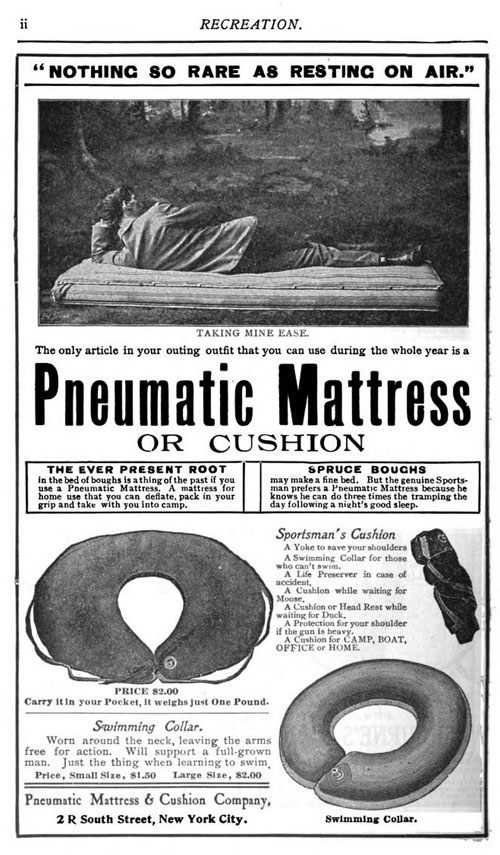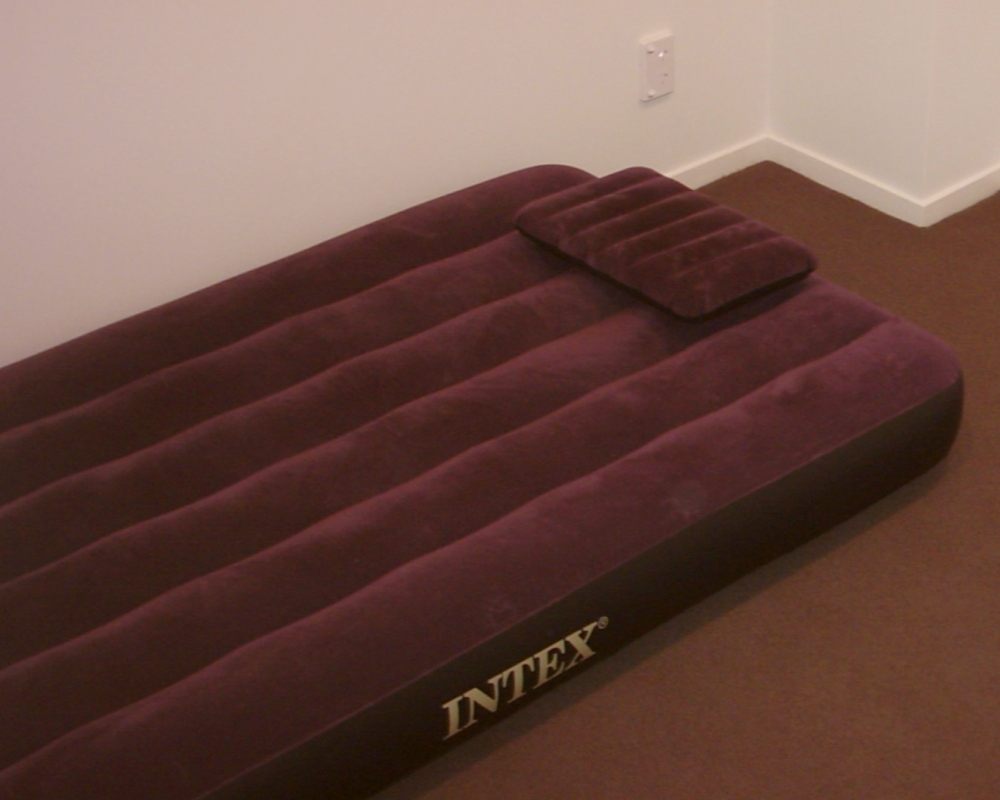From Waxed Canvas To Movie Screens, the History of the Air Mattress
They’ve never been particularly reliable.

A “hipster mattress.” (Photo: iris/CC BY-ND 2.0)
A version of this post originally appeared on Tedium, a twice-weekly newsletter that hunts for the end of the long tail.
Nine months ago, I made a lot of people mad for the dumbest reason. I criticized something that a lot of people surprisingly hold dear: Mattresses.

Specifically, I pondered why the “hipster mattress,” as I controversially called it, had become such a prominent, widely advertised phenomenon online. People got grumpy. I was surprised.
But not as surprised as I was when I stumbled across the airweave, a product whose selling point is that the mattress is mostly air supported by fancy fiber. Its “high rebound airfiber core” makes good marketing copy, but it got me wondering about another kind of lightweight mattress that people sleep on—you know, the kind that don’t cost $1,000 in a twin size.
Here’s how we got the air mattress, the sixth man of bedding.
If you’ve ever done any sort of research on the modern mattress—not the hipster kind, but the standard kind that pokes into your back and makes you sore every single morning—you know that mattress design has evolved very quickly in a relatively short amount of time.
The air mattress, for the most part, is part of that trajectory, but it’s long been unclear exactly where it came from. Mental Floss pins down the invention of the device to the 1889 date when the Pneumatic Mattress & Cushion Company started floating on air, but there is evidence that there were people working on air mattresses long before that. For example, Margaret Frink, a woman who made the trip to California in the midst of the gold rush, offered clear evidence of prior art from way back in 1850:
After putting in our provisions, and other baggage, a floor was constructed over all, on which our mattress was laid We had an India-rubber mattress that could be filled with either air or water, making a very comfortable bed. During the day we could empty the air out, so that it took up but little room. We also had a feather bed and feather pillows.
The earliest patent I can find related to the air mattress comes from 1853, when a man named John Scott combined the benefits of a fabric mattress with the firmness of a giant air bubble. (Scott was onto something: This approach is very similar to that used by the modern-day bed-maker Sleep Number.)

Not everyone was convinced that India rubber was the way to go, though. In a somewhat disturbing 1859 letter to the Boston Medical and Surgical Journal, a man named William Edward Coale recommended using a surgery-like solution to get the ideal air cushions for the treatment of pain:
Get from a butcher a few yards of intestines, thoroughly cleansed; make a number of small pillow-cases or bags of cotton cloth, closed by a drawing string at one end. These should be of various sizes and shapes. Cut the intestines into lengths suitable for filling these. Tie one end of each piece of intestine, turn it wrong side out, blow it up till about three-fourths full, and tie the other end. Introduce this bag of air into its pillow case, and tie the string of it firmly. In this wav, at the cost of not more than half a dollar, two dozen air cushions can be furnished, of all requisite sizes and shapes, adapted to any part of the suffering person.
(To each their own, I guess.)
But this sort of, uh, ingenuity nonetheless showed a lot of progress from the earliest days of the air mattress, which didn’t come from the 19th century … but the 16th—about 200 years before the spring mattress became a thing.
And the invention didn’t come from a rubber-maker or an inventive butcher/surgeon, but an upholsterer. William Dejardin, a French man, came up with the idea of what he called a “wind bed” by using waxed canvas as the material for the mattress. Problem is, according to American Heritage’s Invention & Technology, waxed canvas doesn’t last very long. It’s a bad material for a gigantic bubble of air—which meant that Dejardin’s bubble burst quickly.
Most modern air mattresses that you’ll run into these days are made of polyvinyl chloride (PVC), a material that has become one of the most commonly used plastics. (Vinyl airbeds were made as far back as 1948, according to U.S. patent records.) But because PVC is produced using vinyl chloride, a known carcinogen, people tend to freak out a bit.
Air mattress companies have adjusted by creating more eco-friendly options that don’t use PVC.
Mattress companies have adjusted to the modern day in a lot of other ways as well—including by making better air pumps. The pump on an AeroBed, for example, was a game-changer when it first came out, and its parent company patented the hell out of it.

(Photo: Public domain)
That patent came in handy a decade later, when the firm Intex Recreation Corp. was selling similar mattresses at Wal-Mart for a lower price. Aero Products International sued them both—and won a $12 million judgment.
Fittingly for a company that makes air mattresses, corporate stability is not a thing that AeroBed is particularly known for. The company that’s perhaps the most well-known modern manufacturer of air mattresses has been passed around like one.
Prior to Coleman’s 2010 purchase of the firm, the company had spent time under the wing of a company once known for manufacturing parts for vinyl record players, a private equity firm, and … uh, another private equity firm.
Air mattresses are hugely popular, but if you’re a little on the heavy side, a sack filled with air might not be a good option. According to Coleman, which produces air mattresses under both its own brand name and via its AeroBed subsidiary, a twin air mattress can only hold about 300 pounds—though queen and king sizes are a bit better.
(This issue isn’t just limited to air mattresses, by the way: For bigger folks, thicker mattresses are always better.)
One air mattress that is unlikely to run into problems of weight limits isn’t an air mattress at all. The Airscreen, the massive inflatable screens often used for outdoor movie nights, aren’t cheap, running for thousands of dollars depending on size, but they are fairly innovative and a good way to watch a movie on a lawn chair.
“The screen is like an AeroBed, but vertical,” Robi Blumenstein, a giant screen owner, told the New York Times in 2006.
Modern air mattresses carry a reputation that’s hard to shake: they’re the sleeping hub for the transient. Either you’re sleeping on one because you don’t want to commit to buying a bed, or you’re traveling.
Wesley Schultz, the lead singer of the Lumineers, knows a thing or two about the glory and pain of the air mattress: When his band was just starting to become famous, it was how he went to sleep after a show.
“I remember joking with the band: ‘I’m almost 30, and I’m hauling around this AeroBed that keeps popping.’ I don’t know if this is going to work when I’m 40. Something’s gotta give here,” he told Rolling Stone earlier this year.
Eventually, as Schultz sounds like he’s about to, people tend to outgrow them, ensuring that Casper always has millions of potential millennials ready to buy its piles of pre-shaped foam. Additionally, it helps that air mattresses are the ultimate vessels for people who hate making their beds.
But even if people do outgrow the air mattress, there’s always a place for them in modern society. Just ask Brian Chesky, Joe Gebbia, and Nathan Blecharczyk, the founders of Airbnb.
The trio started renting out their own personal air mattresses in their San Francisco apartment back in 2007. It was the spark of their multi-billion-dollar idea. (That’s right, the “air” stands for air mattress.)
“So, we always have extra accommodations, you know, just in case. This opportunity allowed us to actually monetize those extra airbeds that we had in the extra space that we’re already paying for,” Gebbia explained in a 2010 Mixergy interview. “See, we’re already paying rent for this space. So, what this idea allowed us to do is actually use that space to help pay off our rent.”

(Photo: Chilli Productions/Shutterstock)
Air mattresses have a lot of benefits over traditional beds. For one thing, they’re a lot cheaper; for another, they’re easy to get out of the way in small spaces, which makes them desirable for city dwellers or touring folk bands.
But they have two big problems that make them frustrating to use: First, they are susceptible to the prick of a pin, a nail, or any blunt object that might be hiding in your pocket as you lay on one of these gigantic pillows. But second, and most frustratingly, they seem to lose air even if they’re otherwise fully operational—something immortalized in this Onion article from last year.
We know what causes the former, but what causes the latter? According to a mattress-comparison site called The Sleep Judge, it all comes down to a variety of factors, among them your weight, the elevation where you’re staying, the temperature of the room, and your mattress’ flexibility. The flexibility? Yes, that’s right: the thing that makes an air mattress great is also the thing that takes away its life force.
“No air mattress is airtight,” the website states. “Any mattress that was perfectly airtight would burst the moment you sat down for the evening. Your air mattress must have a bit of room to breathe, and you will lose a small amount of air just by laying down.”
In other words, your mattress will falter. It’s inevitable. If you sleep in one of these things, you will eventually find yourself in a sea of vinyl, trying to pull yourself to shore using whatever’s nearby.
And you will feel pathetic, but on the other hand, everyone else who uses one of these things will be in the same position at some point.
Hey, at least it’s not “high rebound airfiber core.”

A version of this post originally appeared on Tedium, a twice-weekly newsletter that hunts for the end of the long tail.







Follow us on Twitter to get the latest on the world's hidden wonders.
Like us on Facebook to get the latest on the world's hidden wonders.
Follow us on Twitter Like us on Facebook